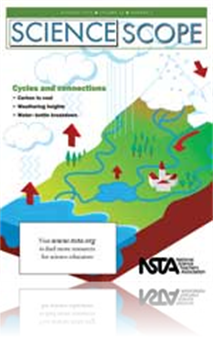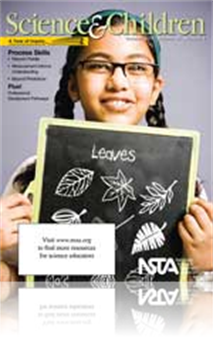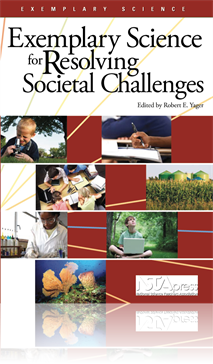All Resources
Journal Article
Since 2002, the PhET Interactive Simulations project at the University of Colorado has been working to provide learning tools for students and teachers. The project has developed over 85 interactive simulations—or sims—for teaching and learning s...
Journal Article
Reading aloud is a widely accepted and successful practice in elementary school classrooms, but is rarely found in middle school classrooms (Allen 2000). However, results from initial research on reading aloud in secondary classrooms support the prac...
Journal Article
Learning about what inferences are, and what a good inference is, will help students become more scientifically literate and better understand the nature of science in inquiry. Students in K–4 should be able to give explanations about what they inv...
Journal Article
The Early Years: Developing Observation Skills
We typically know children are learning when they are able to make sense of an object’s materials or a situation that was previously a bit mysterious and communicate what they have figured out. But what about observing? One of the process skills li...
Journal Article
If we want our students to become capable practitioners of scientific inquiry, we should not stop at providing opportunities to do inquiry. We need to be intentional about assessing and teaching the competencies necessary for inquiry. However, the ab...
Journal Article
The Take Action Project (TAP) was created to help middle school students take informed and effective action on science-related issues. The seven steps of TAP ask students to (1) choose a science-related problem of interest to them, (2) research their...
Journal Article
Science Sampler: An inquiry into the phases of matter
The “What’s the matter With XOD” activity addresses students’ misconceptions and refines their ideas about phases of matter. This activity introduces the characteristics for solids, liquids, and gases, and begins a discussion about physical a...
Journal Article
When life hands you lemons, make a battery! In this article, the authors describe an activity they refer to as Juan’s Dilemma, an extension of the familiar lemon-battery activity (Goodisman 2001). Juan’s Dilemma integrates oxidation and reduction...
Journal Article
Formative Assessment Probes: “More A – More B” Rule
Early-formed preconceptions can be explained by one of the intuitive rules identified by Stavy and Tirosh (2000) called More A – More B. By starting with students’ preconceptions, revealed through the use of a formative assessment probe, teachers...
Journal Article
The Green Room: Introducing The Green Room!
Today, there is a lot out there about “going green”—in your car, at home, for your kids, yourself, your planet. But what about teaching green? In this new column, Amanda Beckrich explores ways to make your classroom, your teaching, and—hopefu...
Journal Article
Science Sampler: The science of soil textures
Off-road motorcycle racing and ATV riding. Gardening and fishing. What do these high-adrenaline and slower-paced pastimes have in common? Each requires soil, and the texture of that soil has an effect on all of them. In the inquiry-based lessons desc...
Journal Article
Like peanut butter and jelly, kindergarteners and dinosaurs go well together. Therefore, the authors developed a cross-curricular unit based on the books All Aboard the Dinotrain (Lund and Fine 2006) and Dinosailors (Lund and Fine 2003). Dinosaur lea...
Journal Article
Every Day Science Calendar: October 2010
This monthly feature contains facts and challenges for the science explorer....
Journal Article
Scope on the Skies: Moon phases
When teaching Moon phases, the focus seems to be on the sequence of Moon phases and, in some grade levels, how Moon phases occur. Either focus can sometimes be a challenge, especially without the use of models and observations of the Moon. In this mo...
Journal Article
The setting: the science classroom. The characters: you and your students. The scene: Your students acting out scientific discoveries, modeling a frog’s life cycle, mimicking the transition from liquid to solid. This is dramatic science, a teaching...
Journal Article
Scope on Safety: Glue guns—Aiming for safety
While glue guns are very useful, there are safety issues. Regardless of the temperature setting, glue guns can burn skin. The teacher should demonstrate and supervise the use of glue guns and have a plan should a student get burned. There should be a...
Journal Article
The New Teacher’s Toolbox: Teaching in the Digital Age
New technologies are engaging today’s students the way PowerPoint did a decade ago. The pressure to go digital can seem especially overwhelming to new teachers, but fear not! Teaching in the digital age is easier than you think. This month’s colu...
Journal Article
Technology can be a powerful tool to increase motivation, engagement, and achievement (Park, Khan, and Petrina 2009). In this article, the authors describe their collaborative approach to integrating technology with a lab on bacterial transformation....
Journal Article
Last year, the author of this month’s Idea Bank had his 11th-grade physics students in Shanghai, China work with students from Chicago, Illinois. Both sets of students were given a list of questions and problems and asked to work together via Skype...
Journal Article
GENIQUEST is a cyberlearning computer program that allows students to investigate biological data using a research-based instructional model. In this article, the authors make the case for using cyberlearning to teach students about the rapidly growi...
Journal Article
Safer Science: “Chemicals of Interest” and More
In the science classroom, developing security involves more than just looking up chemicals. Securing high school science laboratories, preparation rooms, and storerooms is an integral part of protecting schools and the general public from terrorist-t...
Journal Article
Flower petals, acorn hats, exoskeletons of beetles, and lichens are just a few of the objects students may find in a surprising array of vivid colors. These tiny examples from nature’s palette can be discovered in a school yard, a park, or even alo...
Journal Article
NSTA initiated the student chapter program in 2001 to help preservice science teachers at universities and colleges gain access to professional development opportunities and provide support as they enter the profession. Here the authors share example...
NSTA Press Book
Exemplary Science for Resolving Societal Challenges
Amid a flurry of national standards and high-stakes assessments, it’s easy to overlook the curiosity and invention that is inherent to science and that should be central to any science lesson plan. Similarly, the connections between what students l...
eBook
Exemplary Science for Resolving Societal Challenges (e-book)
Amid a flurry of national standards and high-stakes assessments, it’s easy to overlook the curiosity and invention that is inherent to science and that should be central to any science lesson plan. Similarly, the connections between what students l...






